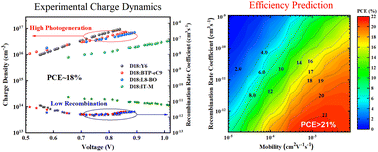High photogeneration and low recombination rate leading to high-performance non-fullerene organic solar cells†‡
Abstract
Non-fullerene (NFA) organic solar cells (OSCs) are gaining a rapid progress currently, with a reported power conversion efficiency (PCE) exceeding 19% in single junction devices. However, further improvement of OSCs is severely hindered by various recombination kinetics mechanisms, thereby requiring a good understanding of charge carrier recombination kinetics that determines the features relevant to photogeneration and recombination. Here in this study, we utilize a transient optoelectronic technique to investigate the impact of nongeminate recombination (NGR) kinetics on device performance in a series of organic solar cells based on material systems consisting of a state-of-the-art electron donor polymer and electron acceptors. It is found that Y6-derivative-based devices exhibit significantly suppressed recombination rate coefficients as low as 2 × 10−12 cm3 s−1 in addition to ultra-high photogeneration (high EQE and broad absorption), leading to a PCE of 18% in the D18:L8-BO device despite a relatively low mobility on the order of 10−4 cm2 V−1 s−1. In contrast, the D18:IT-M device exhibits much less efficient absorption and also much more severe recombination. We apply an enhanced simulation model that jointly takes into account the optical properties, charge recombination, charge carrier mobility and energy level bending at the heterointerface at the same time to predict the new efficiency limit for the NFA OSCs. The simulation reveals that further decreasing the recombination rate coefficient to <2 × 10−13 cm3 s−1 or promoting the mobility to >10−3 cm2 V−1 s−1 can boost the PCE to 21% based on the existing material systems. Our experimental and simulated analysis provides a comprehensive description from the charge carrier recombination kinetics perspective and useful design rules for further improvement in NFA OSCs.

- This article is part of the themed collections: #MyFirstJMCA and Honorary themed collection for Thomas P. Russell


 Please wait while we load your content...
Please wait while we load your content...